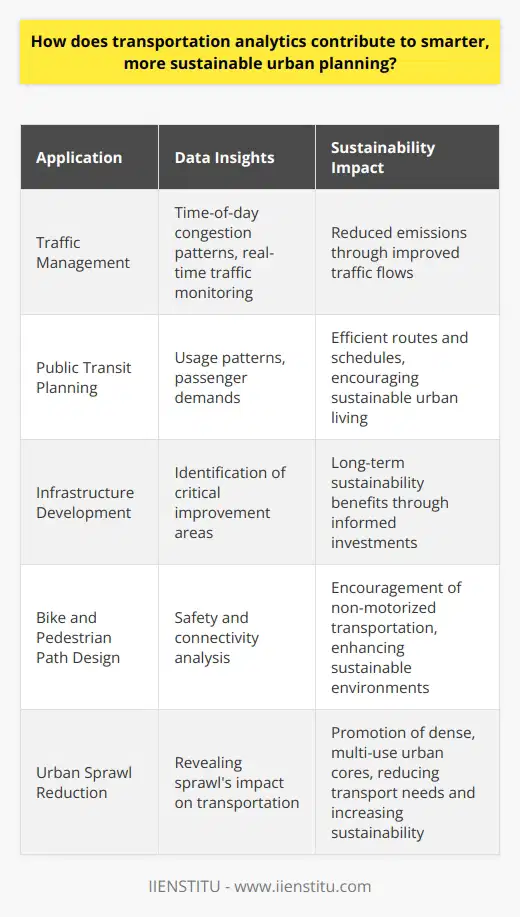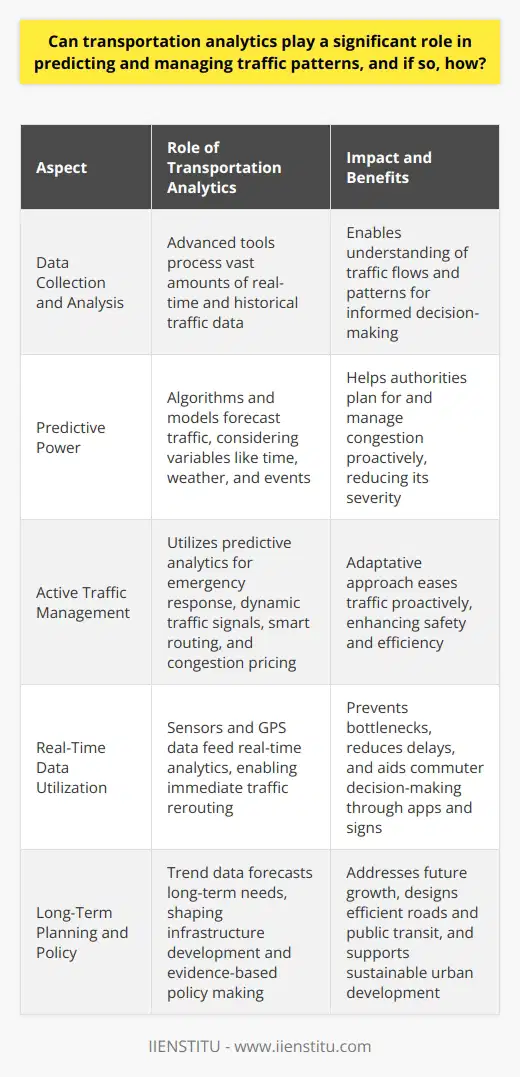
Transportation analytics stands at the forefront of innovation within the transportation sector, offering insights that streamline operations, enhance safety, and promote efficiency. As we delve into the significance of transportation analytics, we aim to illuminate the transformative impact of data interpretation within this industry.
The importance of analytics in transportation cannot be overstated; it is the compass that guides the development of smarter, more responsive transport systems in an age where data is the currency of progress.
Understanding the Basics of Transportation Analytics
Definition and Explanation of Transportation Analytics
Transportation analytics involves the meticulous gathering, examination, and interpretation of data related to transportation systems. The collation of disparate data streams and conversion into actionable insights allows stakeholders to make informed decisions regarding the planning, design, operation, and management of transportation networks. Leveraging what is logistics courses and online certification courses can amplify one's proficiency in applying analytic techniques to real-world transportation challenges.
Importance and relevance in today's transport sector
In today’s world, transportation analytics is the keystone for infrastructure efficiency and customer satisfaction. As the volume and velocity of people and goods on the move continue to swell, the transport sector requires robust analytic strategies to ensure seamlessness and sustainability. These insights facilitate the optimization of routes, predict maintenance needs, and augment capacity planning, ensuring a highly responsive and resilient transport ecosystem.
Exemplification: Use of data in enhancing transportation systems
An illustrative example of transportation analytics at work can be observed in urban traffic management systems. These systems collect data from various sources, including traffic cameras, sensors, and GPS data from vehicles. By analyzing this data in real-time, traffic flow is optimized, reducing congestion and shortening travel times. This proactive approach illustrates the necessity of analytics for addressing the dynamic challenges within the transportation domain.
The Role of Big Data in Transportation Analytics
Logistics Mgmt: System Approach to Transp, Route Plan, Mode Sel, & Vehicle Scheduling
An In-depth Study of Lean Logistics: Excellence in Supply Chains
Key Strategies and Principles for Effective Logistics Management
The Concept of Big Data
Big Data refers to the enormous and complex datasets that traditional data processing software cannot handle efficiently. In transportation, Big Data springs from a multitude of sources such as sensors, ticketing systems, social media, and geographic information systems. The sheer volume, variety, and velocity of these data points necessitate sophisticated analytical tools and frameworks to distill and interpret the gathered information.
How Big Data is used in transportation
Big Data is harnessed within the transportation industry to unlock profound insights into traveler behavior, asset conditions, operational efficiency, and service levels. Such data enables transportation planners and operators to customize and enhance the commuter experience while reinforcing the efficiency of the transportation system. Predicting peak travel times, optimizing freight routes, and improving safety protocols are among the myriad applications of Big Data in transportation.
Impact of Big Data on the transport sector
The advent of Big Data has revolutionized the transport sector, transitioning it from reactive to proactive and predictive paradigms. For instance, the compilation and evaluation of Big Data can facilitate predictive maintenance for public transit systems — foreseeing potential breakdowns before they occur, thus minimizing downtime and expenses.
Case Study: Application of Big Data in a specific transportation system
A compelling case study is the use of Big Data analytics in the metro system of a metropolitan city where data from ticketing, train schedules, maintenance records, and customer feedback are amalgamated. By interpreting this data, the metro system can proactively adjust schedules, perform timely maintenance, and enhance passenger satisfaction, illustrating the profound influence Big Data holds across the transport sector.
Key Components of Transportation Analytics
Descriptive Analytics
Descriptive analytics serves as the foundational layer of transportation analytics, providing a historical perspective into how transportation systems have functioned. These analyses facilitate an understanding of trends and patterns which can inform strategic planning and day-to-day operations. For instance, transit authorities utilize descriptive analytics to review passenger loads and adjust services accordingly.
Predictive Analytics
Predictive analytics employs statistical models and forecasting techniques to envisage future events based on historical data. In the transportation sector, this might include anticipating traffic congestion patterns or predicting potential system failures. Highlighting potential issues before they arise gives organizations the chance to intervene, thereby averting disruptions and enhancing efficiency.
Prescriptive Analytics
Prescriptive analytics goes further by recommending actions you can take to affect desired outcomes. Leveraging sophisticated algorithms and machine learning, prescriptive analytics can suggest optimal routes for delivery trucks or propose the best schedules for rail systems, thereby ensuring operational excellence and customer satisfaction.
Harnessing the Potential of Transportation Analytics
Current trends in Transportation Analytics
Today's transportation analytics are distinguished by a move toward real-time data processing and increased interactivity. Advanced analytic techniques are employed to decipher large datasets quickly, leading to more immediate, impactful decisions. Through modern technologies and dynamic data sources, transportation systems can now adapt in near real-time to the demands of their users.
Case Study: Advanced analytics in modern transportation systems
One such example is the integration of real-time analytics in navigation applications, which process live traffic data to provide users with the fastest possible routes. These systems exemplify how current analytics can respond instantly to changes within the transport environment, enhancing user experiences and streamlining traffic flows.
Challenges in implementing Transportation Analytics
Despite considerable advancements, transportation analytics faces hurdles such as data privacy concerns, the need for extensive infrastructure investments, and the escalation of data complexity. As transportation systems become increasingly digital, corresponding challenges in cybersecurity and data management will demand innovative resolutions.
Strategies to overcome these challenges
To surmount these obstacles, a combination of robust policy frameworks, technical know-how, and collaborative efforts among industry stakeholders is essential. Investing in the ongoing education of professionals through what is logistics courses and online certification courses can foster a more adept workforce proficient in the latest analytical tools and technologies.
The Future of Transportation Analytics
Emerging trends in Transportation Analytics
As we look to the future, transportation analytics is poised to be further augmented by advances in artificial intelligence (AI), machine learning, and the Internet of Things (IoT). These developments promise to enrich the complexity and efficacy of analytics, delivering an unprecedented level of insight and automation to transportation systems worldwide.
Role of AI and other technology in Transportation Analytics
AI and other technologies are expected to play a pivotal role in defining the next generation of transportation analytics. Autonomous vehicles, for example, will not only transform how we travel but also how data is generated and utilized within transportation networks, offering novel opportunities for efficiency and customization.
Possibilities and prospective developments
The foreseeable merger of analytics with emerging technologies may lead to self-healing infrastructure, vehicles that communicate to alleviate congestion, and dramatic improvements in operational robustness and energy efficiency. The synergy of analytics with these advancements will redefine not only the capabilities of transport systems but also the very fabric of urban planning and mobility.
Through our exploration of transportation analytics, we recognize its indispensable role in fostering intelligent, responsive, and sustainable transportation systems. From the basic layers of descriptive analytics to the foresight of predictive analytics, and the directed advice of prescriptive analytics, it is evident that data-driven insights are imperative for the transportation sector's evolution.
The critical role of transportation analytics in shaping the future of the transportation sector is one that cannot be overlooked. As we advance, it will be increasingly vital to embrace and optimize these systems, encouraging all stakeholders to take part in the transport revolution. Through this, we can secure a future where transportation is not only a means of transit but a beacon of efficiency, safety, and sustainability.
Frequently Asked Questions
What are the key benefits of implementing transportation analytics in the field of logistics and supply chain management?
Transportation Analytics in Logistics and Supply Chain Management
Understanding Transportation Analytics
Transportation analytics involves data analysis and modeling. It relates to the movement of goods. Experts use vast data sets here. They find insights. These insights improve logistics and supply chain operations.
Enhancing Efficiency and Reducing Costs
Transportation analytics optimizes routes. It lowers fuel consumption. It also minimizes delivery times. This efficiency reduces operational expenses. Companies can track vehicles in real-time. They streamline their supply chains. Analytics detect patterns. It predicts future challenges.
Improving Customer Satisfaction
Customers demand fast, reliable deliveries. Transportation analytics helps meet these expectations. It improves accuracy. It boosts speed. This analytics provides delivery status updates. Timely deliveries satisfy customers. Satisfaction builds brand loyalty.
Strategic Planning and Decision Making
Analytics aids in strategic planning. It provides comprehensive insights. Companies understand market trends better. They adapt more effectively. They can foresee demand changes. Resources get allocated smartly. Decisions become data-driven.
Risk Mitigation and Crisis Management
Supply chains face many uncertainties. Transportation analytics anticipates disruptions. It plans for risks. Companies can react quickly to unforeseen events. They manage crises better. This approach minimizes the impact.
Sustainability in the Supply Chain
Sustainable practices are crucial today. Analytics promotes sustainability. It optimizes routes. It reduces carbon emissions through efficiency. Companies make greener choices. They demonstrate environmental responsibility. This eco-friendliness can attract new customers.
Competitive Advantage
Efficient transportation differentiates companies. Analytics provides a competitive edge. It offers unique customer service approaches. It improves reliability. This difference can capture market share. It strengthens positioning.
Inventory Management Optimization
Analytics integrates with inventory management. It aligns transportation with stock levels. Overstocking and understocking reduce. Capital gets freed. Working capital improves. Resources deploy more effectively.
Transportation analytics transforms logistics. It cuts costs. It pleases customers. It enables better decisions. It manages risks well. It supports sustainability. It gives a competitive advantage. It aligns inventory management. In a data-driven age, logistics benefit immensely from analytics.

How does transportation analytics contribute to smarter, more sustainable urban planning?
Transportation Analytics in Urban Planning
Transportation analytics has transformed urban planning. It equips planners with valuable insights. These insights guide smarter, more sustainable choices.
The Role of Data Insights
Planners gather and analyze transportation data. Advanced tools help in this process. They take in vast amounts of information. Big data equips planners with real-time insights. These insights drive decisions on urban mobility.
Impact on Traffic Management
Data allows for better traffic predictions. It informs on time-of-day congestion patterns. Planners can then mitigate traffic-related issues. Improved flows reduce emissions, aiding sustainability.
Facilitating Public Transit Improvements
Analytics support public transportation planning. They show usage patterns and passenger demands. Planners optimize routes and schedules accordingly. Efficient public transit boosts sustainable urban living.
Optimizing Infrastructure Development
Transportation data guide infrastructure investments. Planners identify critical improvement areas. Sustainability guides infrastructure projects. This ensures long-term urban planning benefits.
Design of Bike and Pedestrian Paths
Data supports the design of non-motorized networks. Safety and connectivity get enhanced. Networks encourage walking and biking. These bolster sustainable urban environments.
Reduction of Urban Sprawl
Analytics reveal how urban sprawl affects transport. Planners craft strategies to curb expansion. They promote dense, multi-use urban cores. This approach reduces transport needs, thus sustainability rises.
Enhancing Policy Development
Policymakers rely on robust data for decisions. Transportation analytics inform policy. These policies align with sustainable urban growth goals.
Benefits of Analytics-Driven Planning:
- Improved traffic flow
- Reduced carbon footprint
- Robust public transit systems
- Cost-effective infrastructure spending
Challenges to Consider:
- Protecting individuals' privacy
- Ensuring data accuracy
- Keeping analytics methods up-to-date
Transportation analytics is crucial. It advances urban planning towards sustainability. Cities become smarter, greener, and more livable. We need sustained commitment to its potential. It promises a sustainable future for urban environments.

Can transportation analytics play a significant role in predicting and managing traffic patterns, and if so, how?
The Role of Transportation Analytics in Traffic Management
Transportation analytics holds significant potential for predicting and managing traffic patterns. Advanced data collection and analysis tools allow for the processing of vast amounts of information. Real-time and historical data become vital in understanding traffic flows.
Predictive Power of Analytics
Transportation analytics uses algorithms and models to forecast traffic. It considers variables like time, weather, and events. Predictions help authorities plan for and manage congestion before it worsens. Machine learning further refines these forecasts over time, increasing accuracy.
Impact on Traffic Management
Active traffic management benefits from predictive analytics. Emergency response teams depend on analytics for the quickest routes. Dynamic traffic signals, smart routing, and congestion pricing schemes use analytics. This adaptative approach helps ease traffic proactively.
Real-Time Data Utilization
Sensors and GPS data feed real-time analytics. This immediacy helps reroute traffic as conditions change. Updates reach commuters through apps and signs, aiding decision-making. Real-time responses prevent bottlenecks and reduce delays.
Long-Term Planning and Policy
Analytics shape infrastructure development. Planners use trend data to forecast long-term needs. They address future growth, designing roads and public transit accordingly. Evidence-based policy making stems from robust traffic analysis.
Environmental and Economic Benefits
Efficient traffic flow reduces emissions and saves fuel. This directly links to environmental sustainability. Indirectly, better traffic patterns support economic growth. Smooth flows reduce transport times, benefiting trade and commerce.
Challenges in Analyzing Traffic Data
Despite the potential, challenges persist. Data privacy concerns and technology costs stand out. Analysts must balance utility with ethical considerations. Investments into technology reap benefits but require substantial funding.
Transportation analytics, thus, plays a pivotal role in traffic management. Through data-driven decisions, it offers a path towards smoother and smarter traffic systems.



